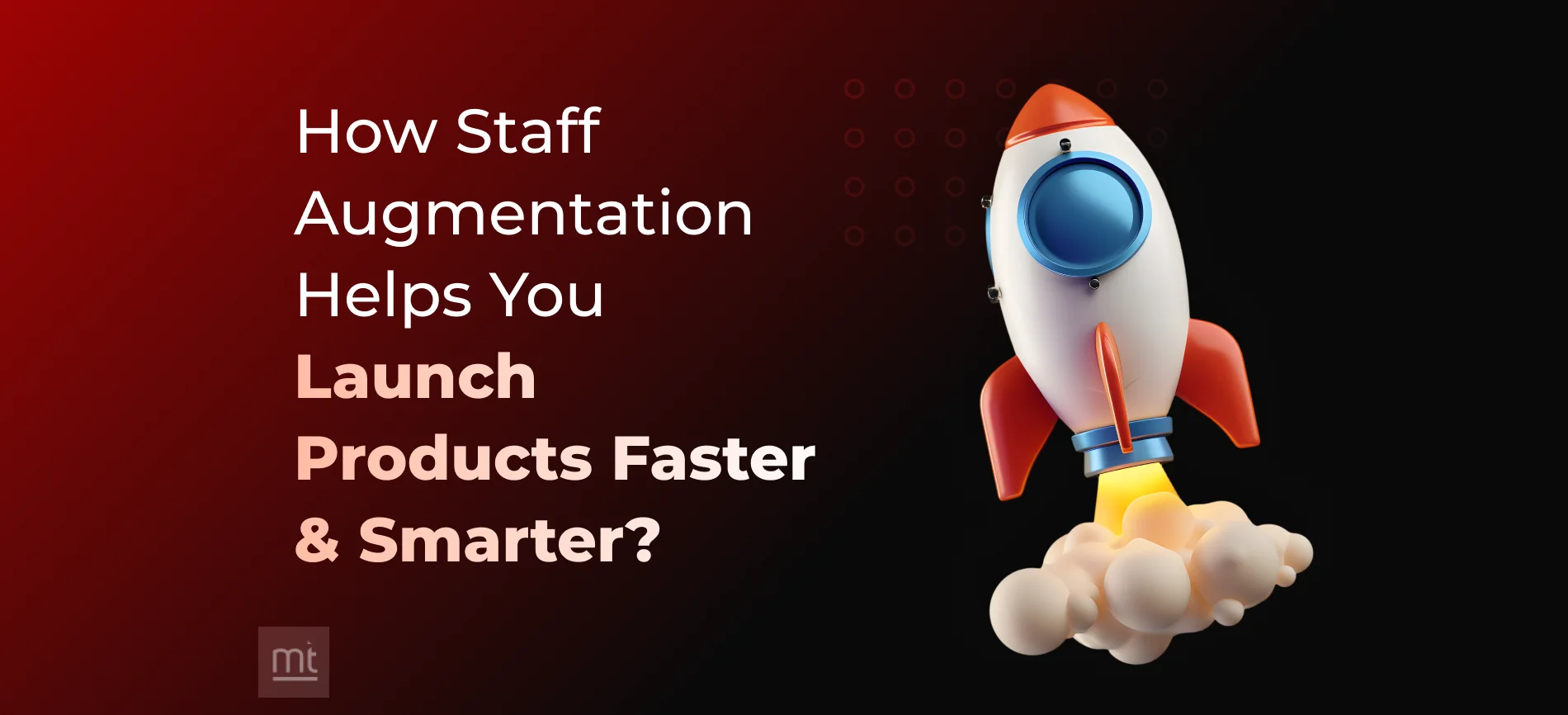Get Free Trial Week Developer Access, Try Before You Hire. Click Here to Claim Now
Introduction:
Microservices is the buzzing word in the software industry these days. It is in the talks for providing more scalable, flexible, and agile applications than previous software architectures. It runs on the principle of breaking down into small elements. That is creating small independent services that combine to form a software application.
Today in our blog, we will discuss the evolution of microservices in the software industry, how it is beneficial in software development, and much more. But let us first understand what microservice is and how it works.
What Are Microservices?
Microservices are referred to as small, independent, and self-contained software components that come together to form an application. It is an architectural approach to software development where an application is created as a combination of these individual software modules with distributed memory.
Each module or microservice is designated with a specific task and performs that best. These modules are used in software development via communication interfaces, mostly APIs(Application Programming Interfaces).
For example, if you are developing a ticket booking software, you will require a book ticket function under circumstances. Here with microservice architecture, you can create a “Book ticket” API, that specifically does the task and uses it whenever required in the software development.
Now let us understand how the microservice architecture works.
How Does Microservice Architecture Work?
Microservice Architecture is a way of developing software with a structured combination of independent microservices. Each microservice in the architecture has a specific role to play. Each of them is responsible for one distinct business operation.
For example social media login, track shipping history, and process payments. These microservices will remain the same for different applications. They will serve as building blocks for creating specific pages in different applications. Updates to these microservices will not hamper any application but will upgrade its features as required.
It is a decentralized approach to building complex software. Each service can exist in its own isolated environment and undergo rebuilding or testing, without hampering the overall functionalities of the whole application.
It is way more advanced and flexible than the traditional monolithic architecture. For a better understanding let us discuss the difference between service-oriented architecture, monolithic architecture, and microservice architecture.
How is Microservice Architecture Different From Service-oriented Architecture, and Monolithic Architecture?
The software industry has evolved from service-oriented architecture to monolithic architecture to microservices gradually. Here we are comparing all three architectures to understand the need and evolution of microservices in modern software architecture.
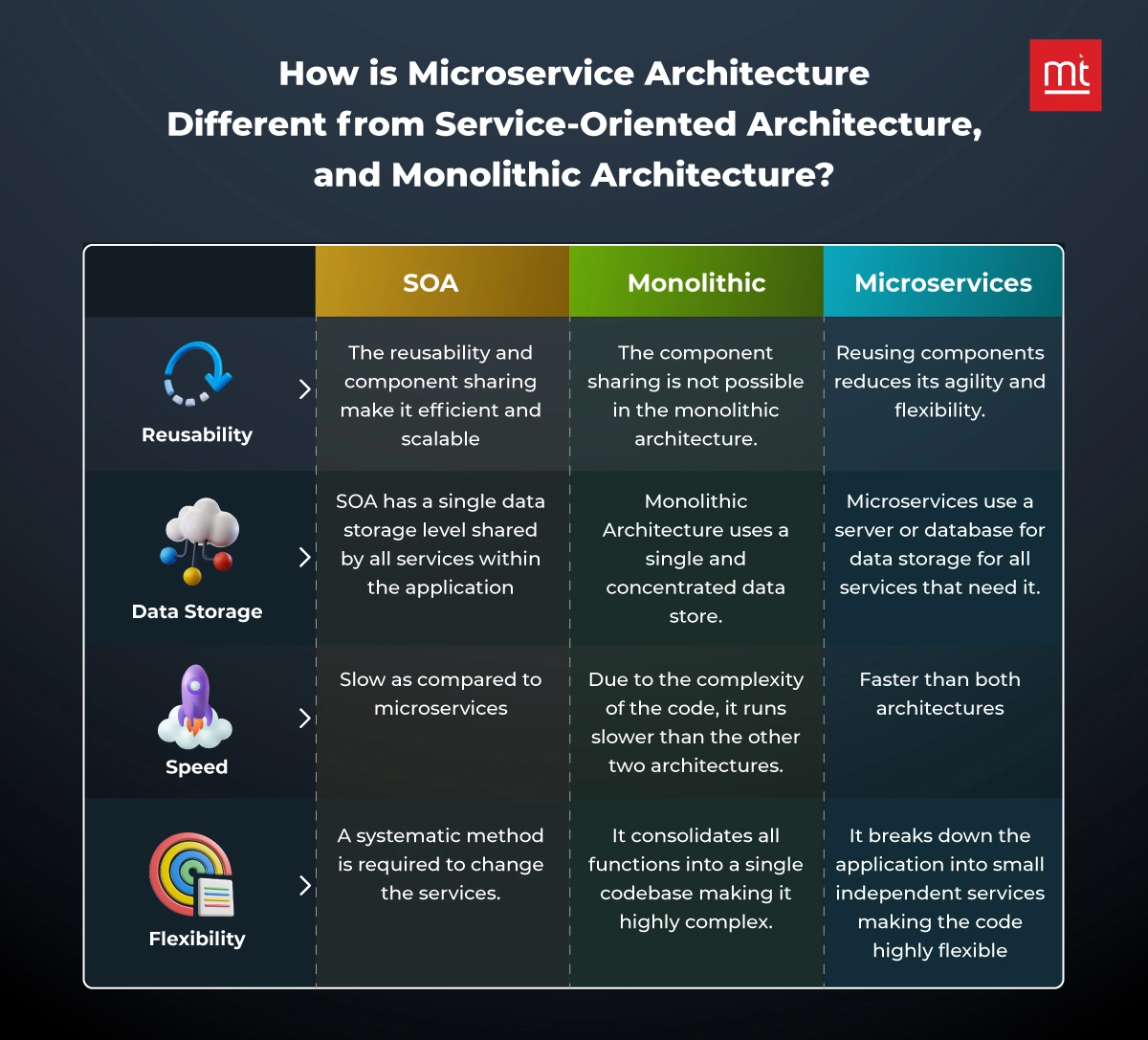
Benefits of Microservices
Microservices come with lots of benefits that encourage software developers to integrate them in modern software architecture. Some of the benefits are:
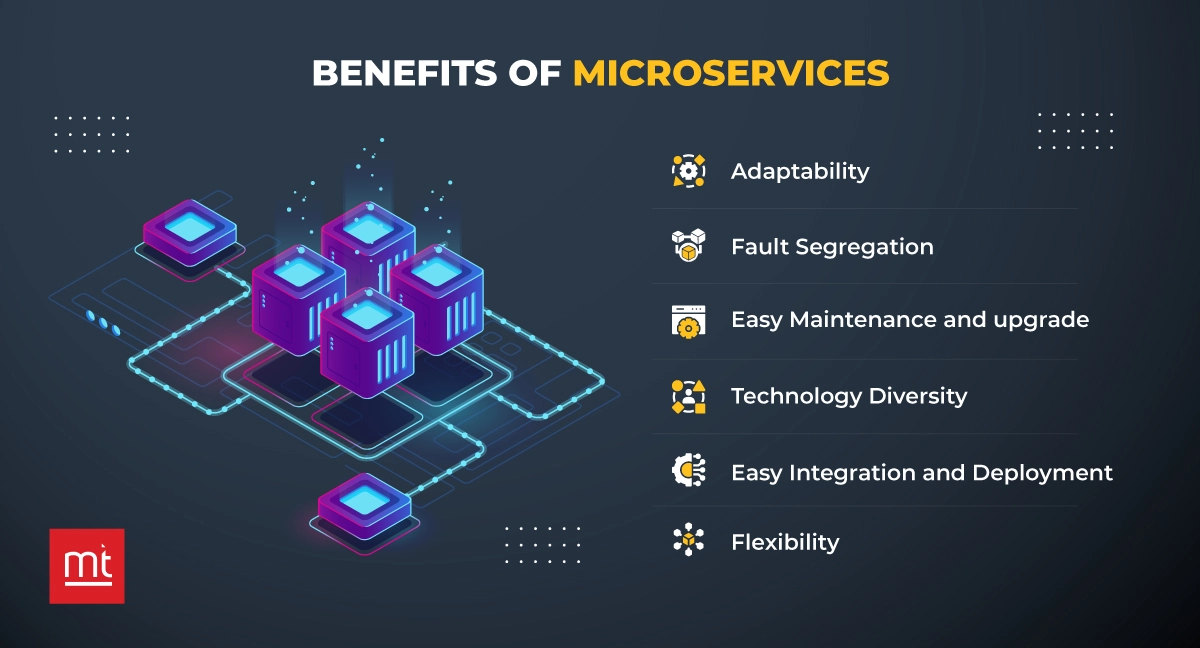
1. Adaptability
Microservices permit independent scaling of individual services based on their demand. This means you can allocate the resources precisely wherever needed without hampering the entire system.
2. Fault Segregation
All the components in a microservice architecture are independent of each other. As a result, the failure of one microservice does not bring down the whole system. With all other services continuously functioning, it becomes easy to isolate the infected one to fix the problem. This makes the system more reliable.
3. Easy Maintenance and upgrade
With microservices being independent of each other, it becomes easier to update, maintain, and deploy each service without disrupting the entire system. This sanctions regular upgrades and bug fixing of the whole system, increasing its stability and security.
4. Technology Diversity
With microservices, developers have the freedom to select distinct technologies and tools for the development of each service. This promotes innovation with the adoption of new technologies in modern software development.
5. Easy Integration and Deployment
Microservices can be integrated easily, allowing a seamless communication of services within the software. Each microservice being independent of the other, allows the continuous deployment and delivery of the service. It promotes adding new features to the software frequently without disrupting the old system.
6.Flexibility
Teams can work on different services simultaneously, using different programming languages, tools, and frameworks. This flexibility encourages the development, deployment, and updates in any microservice-oriented software.
Challenges with microservices
Though microservices offer compelling benefits in the development of modern software architecture, it also has some challenges that one must consider when choosing microservices over other architectures.
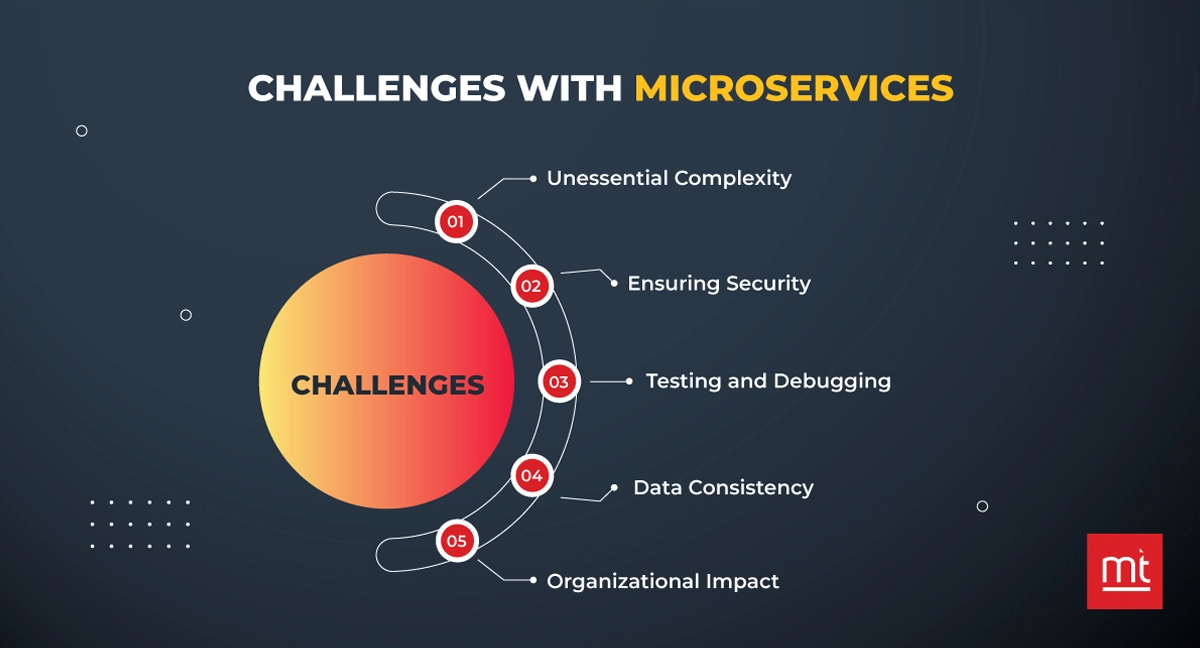
1. Unessential Complexity:
Microservices architecture comes with multiple independent microservices. Combining all these services to form a robust software application is a highly complex task. Managing interactions in a distributed system can affect the data consistency and fault tolerance capacity of software.
2. Ensuring Security
With a distributed system, ensuring security across multiple services and managing access controls becomes a difficulty. Because of diverse technologies used for different services, the chances of attack surfaces increase, demanding robust security at each level.
3. Testing and Debugging
Testing microservices architecture would call for a structured process as it does not involve only the microservice testing but also its interactions with other services. Hence, end-to-end testing and debugging become complex requiring sophisticated testing strategies.
4. Data Consistency
Maintaining data consistency among multiple microservices can be quite challenging. Transaction management becomes complex when a business process spans multiple microservices. Ensuring data integrity at this stage requires a careful design.
5. Organizational Impact
Adopting microservices often brings organizational impact to the company. The team needs to interact effectively, and there can be a change in the organizational structure to align with service ownership which can lead to confusion and miscommunication.
Real-world examples of microservices architecture usage
While the world is understanding the term microservices and trying to incorporate it into their software architecture. There are already pioneers who have made it successfully and are getting fruitful results.
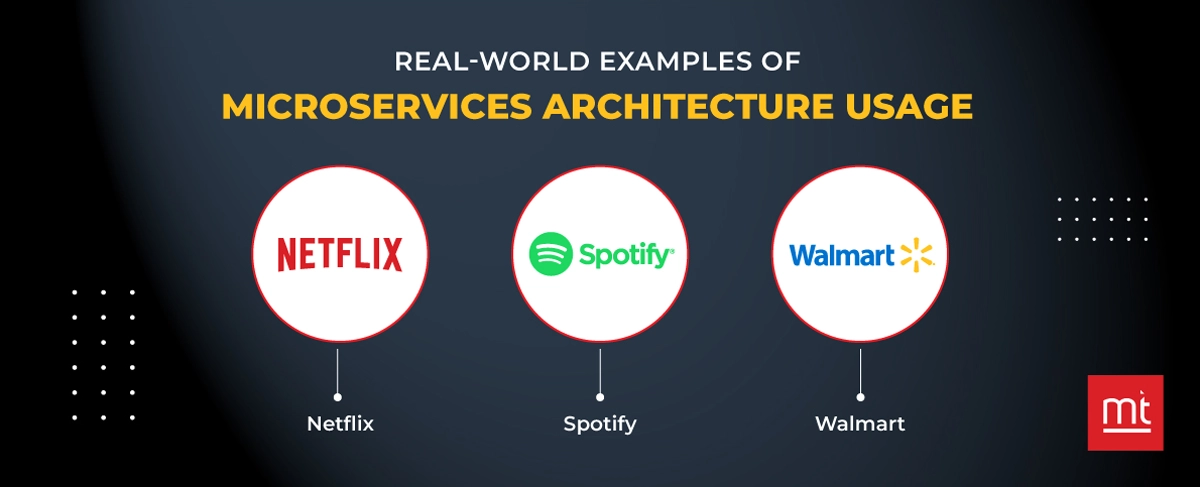
1. Netflix
Back in the days, when Netflix was following the monolithic architecture, it was suffering from error and downtime. A single error in the application resulted in hours of downtime. But with a transition to microservices, it has achieved improved versatility and resilience.
With the help of microservices, Netflix is capable of handling 2 billion API edge requests every day and can support around 500 microservices.
It has resulted in its growth at a 1000x pace with service expansion to 130 countries in the world.
Overall, It is successfully serving a massive user base with a flawless streaming experience after incorporating microservices in its architecture.
2. Spotify
Spotify has welcomed microservices in the form of multiple new features added for its users. With the addition of microservices architecture to the application, Spotify uplifted the user experience by adding the personalization feature to the app.
It has multiple microservices working in the background like music recommendations, user playlists, personalized content, etc.
Including microservices in its software architecture has made Spotify more scalable, agile, and flexible.
3. Walmart
Walmart has faced 2 big website crashdown on its sales days. Its monolithic architecture was not able to handle the pressure of 6 million visitors per minute. As a result, they faced a major loss on big days such as Black Friday sales.
After that, the company made a swift transit towards microservice architecture and the results it got were commendable. It was then able to handle double traffic on sales day, mobile orders increased, and much more.
Microservices constituted a positive transformation for Walmart and secured its position as the world's largest retailer.
Conclusion
Microservice architecture has undoubtedly made its space in modern software development. Amid the difficulties faced while incorporating, it has still attracted the organizations with its capabilities. The scalability and flexibility it offers to massive and complex systems are applaudable.
Software developers at Manektech are also impressed by the microservices and are now flawlessly incorporating them into the development process. If you are looking for microservice experts to develop software and applications for your organization, Connect with us Today!
Subscribe to Our Newsletter!
Join us to stay updated with our latest blog updates, marketing tips, service tips, trends, news and announcements!



